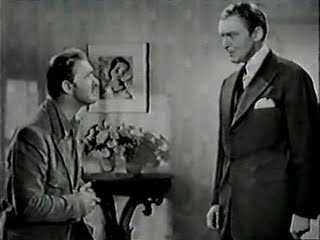
AMONG THE LIVING
US, 1941, 67 minutes, Black and white.
Albert Dekker, Susan Hayward, Harry Carey, Frances Farmer.
Directed by Stuart Heisler.
Among the Living has more plot for a 67-minute film than many a two-hour epic. It relies on the theme of twins, a good twin and a bad twin. However, the bad twin is the victim of his brutal father who had injured him twenty-five years before the film starts. The twins are played by Albert Decker. The wife of the good twin is played by Frances Farmer who appeared in few films but was the subject of the Jessica Lange biopic, Frances. The film also has an early appearance by Susan Hayward.
The film is set in a mill town which gives it a realistic atmosphere for the conventions of a horror and murder movie. The film recreates the atmosphere of the time, the mill, the wealthy homes, the honky tonk.
Director Stuart Heisler was to go on to more substantial films with quite a range including the thriller The Glass Key, Gary Cooper and Loretta Young in Along Came Jones, Fred Astaire musical, Blue Skies and two films with Susan Hayward, Smash Up: The Story of a Woman and Tulsa. During the 1950s he directed Storm Warning, The Star and I Died a Thousand Times.
1. Expectations from the title, reference? An entertaining melodramatic thriller?
2. The black and white photography, location and studio photography and visuals? Melodramatic music? The special effects of' Albert Decker playing twin roles?
3. How interesting a thriller, the conventions of haunted houses, mob attitudes after murder, lynching mentality? The mystery of the hidden twin, the gradual revelation? The melodramatic tone of the film? entertainment value? A film of the early 40s?
4. Was the plot meant to be credible, realistic? Contrived for thriller purposes? Doctor Saunders and the death certificate about Paul, the hiding of it for twenty-five years? The build-up of Doctor Saunders, research? The Raden township and heritage, the mills? The people in the town? The murders and violence? Paul's ability to immerse himself in the town? John as hero, confronted suddenly with the truth, his attitudes of taking responsibility, his almost being lynched? Did the credibility matter within the short running time of the film?
5 How interesting were the twins? Paul and the explanation of his muteness, sympathetic, murderous? The importance of the experience with Millie and offering her money? Then his murders? Millie turning against him?
6. The contrast with John as the conventional hero, his wife, funeral, the doctor, Pompey and his friendship? The confrontation with opening the mill, the problems of Paul, his handling of them - and his running away and the denouement in the cemetery? Sufficient for this kind of film?
7. Doctor Saunders as an enigmatic figure, with Pompey, Paul, wanting to evade responsibility, his ‘heroism’ at the end, going off with the sheriff?
8. Millie and the feminine interest, her mother and the boarding house, the dress, her boy friend, her turning Paul? Millie as the symbol of the crowds in the town, her mother, boy friend, the mill workers and their hostility to the family e.g. at the funeral. the mass hysterics at the end? The atmosphere in the town, the social comment as regards the mill, rich families, the South and madness, exploitation of the people? the black servant? The importance of the atmosphere in the town for the lynching of Elaine Raden? The film's comment on this mass hysteria?
9. The atmosphere of horror? Murders, Pompey’s death and his gesture? The horror of the people doing exactly the same kind of thing in wanting to lynch Raden?
10. Human themes, social themes, values of good and evil?